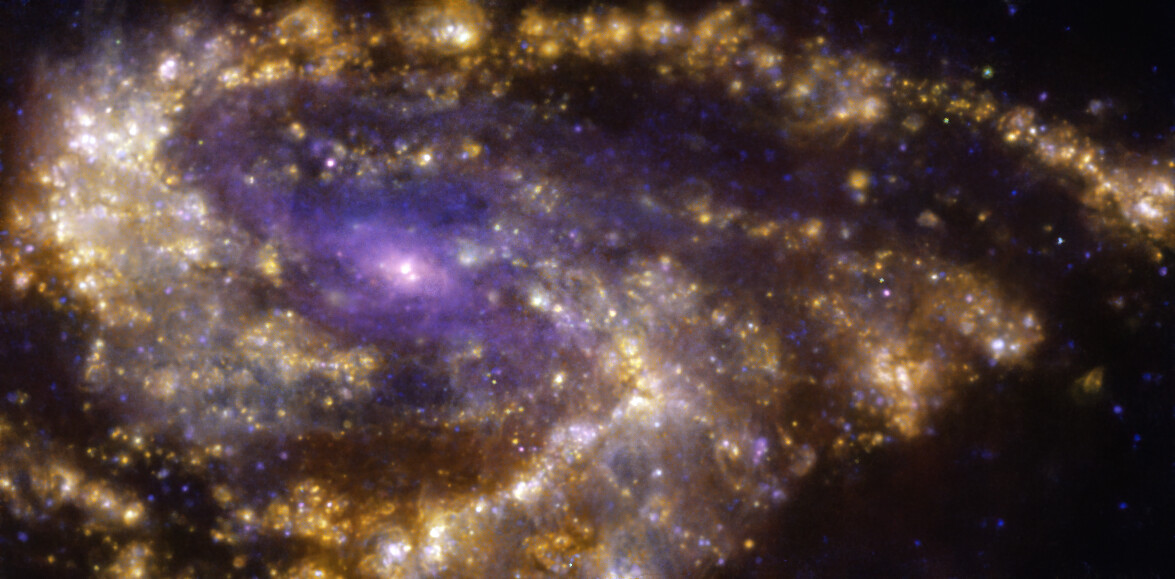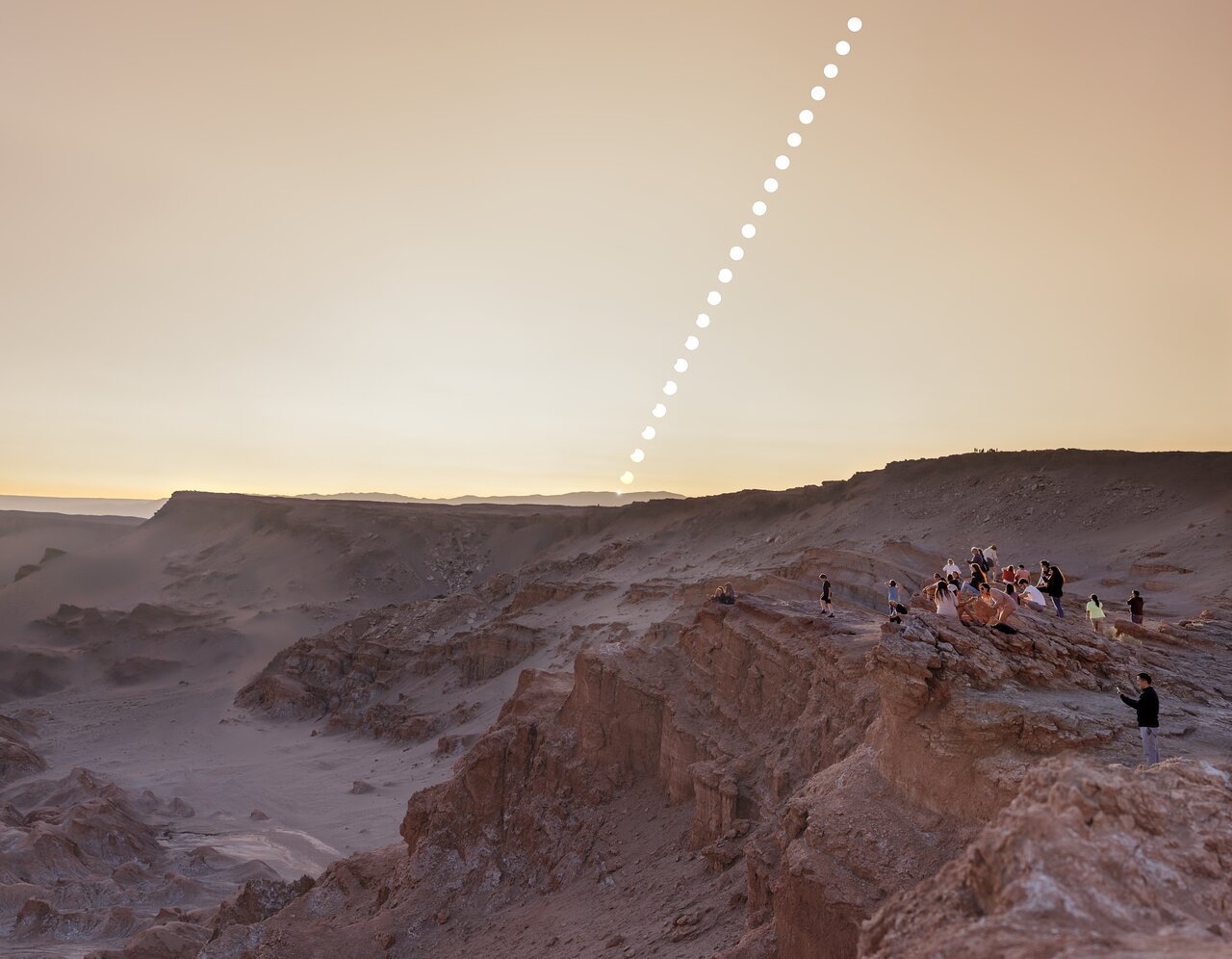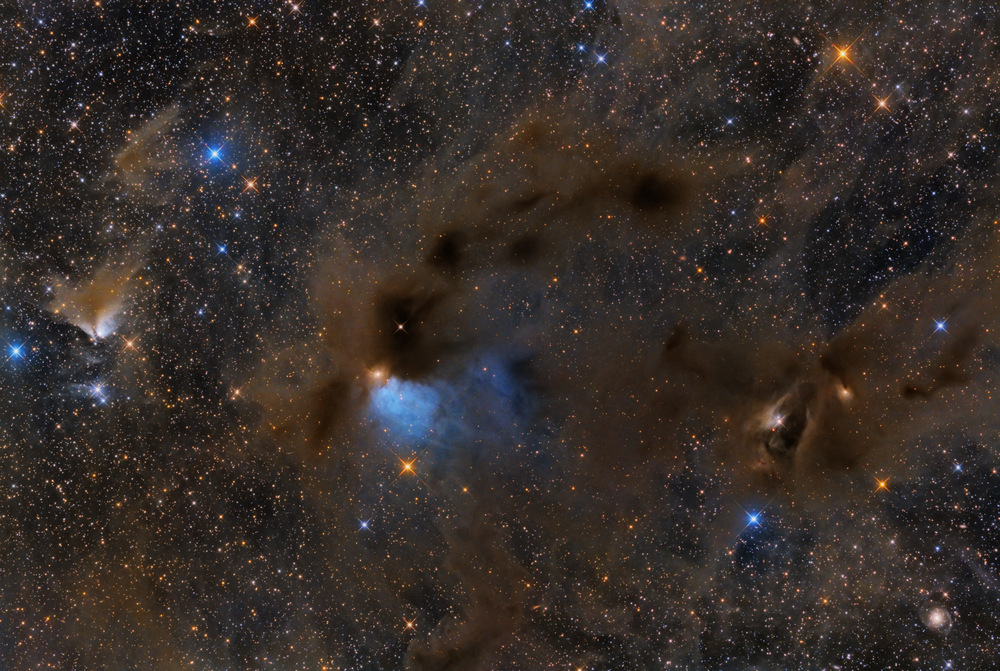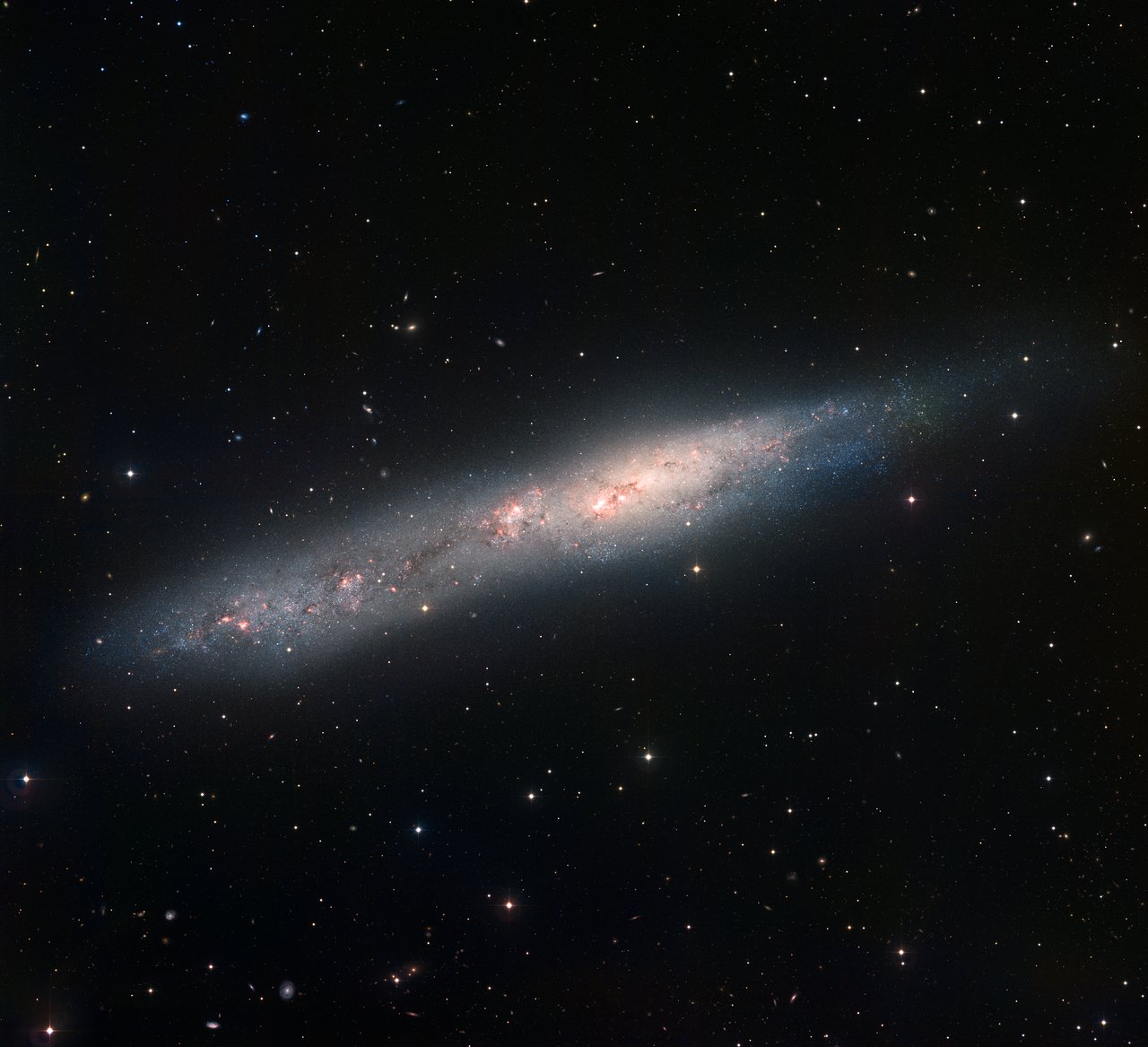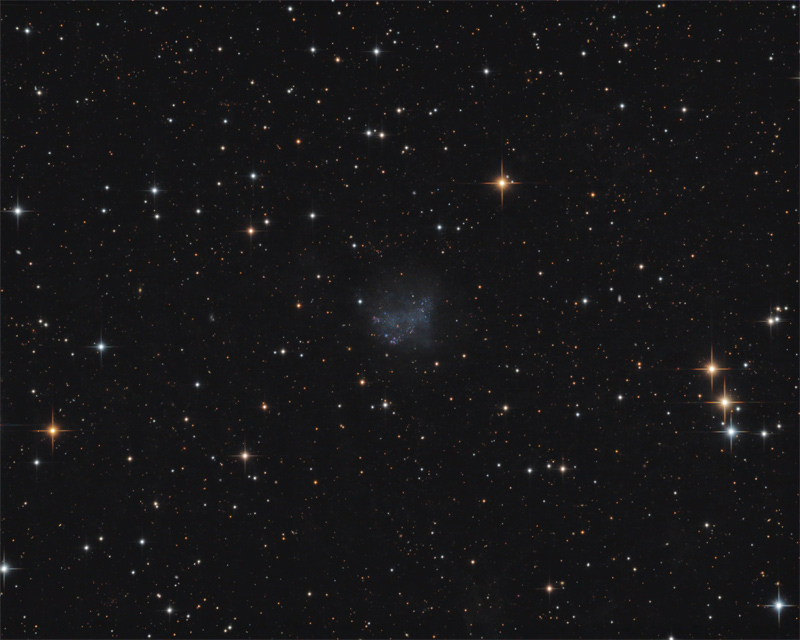Found Images: 2022 May
Found Images: 2022 May
Have you seen a great image or video somewhere that you think would make a great APOD? Nominate it for APOD! Please post as much information here as you have about the image/video with a link to any source(s) for it you know of here, and the editors will take a look.
When posting the image itself, please do not post anything larger than a thumbnail here; please honor the copyright holder's copyright.
Please keep hotlinked images under 500K.
Thank you!
<< Previously
Know the quiet place within your heart and touch the rainbow of possibility; be
alive to the gentle breeze of communication, and please stop being such a jerk. — Garrison Keillor
alive to the gentle breeze of communication, and please stop being such a jerk. — Garrison Keillor
ESO: Purple Haze (Messier 66)
Purple Haze
ESO Picture of the Week | 2022 May 02
ESO Picture of the Week | 2022 May 02
This Picture of the Week showcases the impressive NGC 3627 galaxy, also known as Messier 66, located approximately 31 million light-years from Earth in the constellation Leo. The image was taken with the Multi-Unit Spectroscopic Explorer (MUSE) on ESO’s Very Large Telescope (VLT) in Chile. But why does it have these unusual colours?
This image is a combination of observations conducted in different wavelengths of light. But rather than seeing the stars in this galaxy, as in more classical images, what this image displays is gas ionised by newly-born stars, with hydrogen, oxygen and sulphur shown in red, blue and orange respectively.
The image was taken as part of the Physics at High Angular resolution in Nearby GalaxieS (PHANGS) project, which is using telescopes operating across all wavelengths to make high-resolution observations of nearby galaxies. The goal of the project is to better understand what triggers, boosts or holds back the formation of new stars in different environments.
Know the quiet place within your heart and touch the rainbow of possibility; be
alive to the gentle breeze of communication, and please stop being such a jerk. — Garrison Keillor
alive to the gentle breeze of communication, and please stop being such a jerk. — Garrison Keillor
ESA: Hubble Sees Double in M99
Hubble Sees Double in M99
ESA Hubble Picture of the Week | 2022 May 02
ESA Hubble Picture of the Week | 2022 May 02
The magnificent spiral galaxy M99 fills the frame in this image from the NASA/ESA Hubble Space Telescope. M99 — which lies roughly 42 million light-years from Earth in the constellation Coma Berenices — is a “grand design” spiral galaxy, so-called because of the well-defined, prominent spiral arms visible in this image. M99 was captured by Hubble’s Wide Field Camera 3 on two separate occasions, helping astronomers study two entirely different astronomical phenomena.
The first set of observations aimed to explore a gap between two different varieties of cosmic explosions; novae and supernovae. Novae, which are caused by the interactions between white dwarfs and larger stars in binary systems, are far less bright than the supernovae which mark the catastrophically violent deaths of massive stars. However, current astronomical theories predict that sudden, fleeting events could occur that shine with brightnesses between those of novae and supernovae. Despite being described by astronomers as being shrouded in mystery and controversy, just such an event was observed in M99. Astronomers turned to Hubble’s keen vision to take a closer look and precisely locate the fading source.
The second set of observations were part of a large Hubble project which aims to chart the connections between young stars and the clouds of cold gas from which they form. Hubble inspected 38 nearby galaxies, identifying clusters of hot, young stars. These galaxies were also observed by the Atacama Large Millimeter/submillimeter Array (ALMA), a colossal radio telescope consisting of 66 individual dishes perched high in the Chilean Andes. The combination of Hubble’s observations of young stars and ALMA’s insight into clouds of cold gas will allow astronomers to delve into the details of star formation, and paves the way for future science with the NASA/ESA/CSA James Webb Space Telescope.
Know the quiet place within your heart and touch the rainbow of possibility; be
alive to the gentle breeze of communication, and please stop being such a jerk. — Garrison Keillor
alive to the gentle breeze of communication, and please stop being such a jerk. — Garrison Keillor
-
starsurfer
- Stellar Cartographer
- Posts: 5409
- Joined: Thu Mar 15, 2012 7:25 pm
-
starsurfer
- Stellar Cartographer
- Posts: 5409
- Joined: Thu Mar 15, 2012 7:25 pm
-
starsurfer
- Stellar Cartographer
- Posts: 5409
- Joined: Thu Mar 15, 2012 7:25 pm
-
starsurfer
- Stellar Cartographer
- Posts: 5409
- Joined: Thu Mar 15, 2012 7:25 pm
NOIRLab: Galactic Ballet Captured from Chile
Galactic Ballet Captured from NSF’s NOIRLab in Chile
NSF | NOIRLab | 2022 May 03
NSF | NOIRLab | 2022 May 03
The barred spiral galaxy NGC 1512 (left) and its diminutive neighbor NGC 1510 were captured in this observation from the Víctor M. Blanco 4-meter Telescope. As well as revealing the intricate internal structure of NGC 1512, this image shows the wispy outer tendrils of the galaxy stretching out and appearing to envelop its tiny companion. The starry stream of light that connects the two galaxies is evidence of the gravitational interaction between them — a stately and graceful liaison that has been going on for 400 million years. NGC 1512 and NGC 1510’s gravitational interaction has affected the rate of star formation in both galaxies as well as distorting their shapes. Eventually, NGC 1512 and NGC 1510 will merge into one larger galaxy — a drawn-out example of galactic evolution.Image Credit: Dark Energy Survey/DOE/FNAL/DECam/CTIO/NOIRLab/NSF/AURA
Processing: T.A. Rector (University of Alaska Anchorage/NSF’s NOIRLab), J. Miller
(Gemini Observatory/NSF’s NOIRLab), M. Zamani & D. de Martin (NSF’s NOIRLab)
These interacting galaxies lie in the direction of the constellation of Horologium in the southern celestial hemisphere and are around 60 million light-years from Earth. The wide field of view of this observation shows not only the intertwined galaxies, but also their star-studded surroundings. The frame is populated with bright foreground stars within the Milky Way and is set against a backdrop of even more distant galaxies. ...
Know the quiet place within your heart and touch the rainbow of possibility; be
alive to the gentle breeze of communication, and please stop being such a jerk. — Garrison Keillor
alive to the gentle breeze of communication, and please stop being such a jerk. — Garrison Keillor
-
starsurfer
- Stellar Cartographer
- Posts: 5409
- Joined: Thu Mar 15, 2012 7:25 pm
-
starsurfer
- Stellar Cartographer
- Posts: 5409
- Joined: Thu Mar 15, 2012 7:25 pm
-
starsurfer
- Stellar Cartographer
- Posts: 5409
- Joined: Thu Mar 15, 2012 7:25 pm
Re: Found Images: 2022 May
-
starsurfer
- Stellar Cartographer
- Posts: 5409
- Joined: Thu Mar 15, 2012 7:25 pm
Re: Found Images: 2022 May
NGC 1097
https://www.chart32.de/index.php/component/k2/item/413
Copyright: CHART32
Processing: Konstantin Buchhold
https://www.chart32.de/index.php/component/k2/item/413
Copyright: CHART32
Processing: Konstantin Buchhold
ESO: Partial Eclipse over Chile’s Atacama Desert
Partial Eclipse over Chile’s Atacama Desert
ESO Picture of the Week | 2022 May 09
ESO Picture of the Week | 2022 May 09
This picture of the week shows the partial solar eclipse that was visible over Chile’s Atacama Desert on 30 April 2022. The photograph was taken in San Pedro de Atacama, above the Valle de la Luna (Moon Valley). This is near the site of the Atacama Large Millimeter/sub-millimeter Array (ALMA), which is co-owned and co-operated by the ESO on behalf of its European partners.
In the photo, you can see a sequence of images showing the partial solar eclipse, caused by the Moon obscuring a fraction of our line of sight to the Sun. This gives the impression of a small section of the Sun having been cut out. The whole sequence lasted just 54 minutes, and visitors to the scene were pleasantly surprised by it, expecting a regular sunset instead.
The Valle de la Luna is also bathed in the dusty glow of the volcanic sunset, caused by the ash of the Hunga Tonga volcano which erupted in December 2021. This ash is trapped high in the atmosphere, casting a soft dawn-like light that gives the scene an unusual martian feeling.
Know the quiet place within your heart and touch the rainbow of possibility; be
alive to the gentle breeze of communication, and please stop being such a jerk. — Garrison Keillor
alive to the gentle breeze of communication, and please stop being such a jerk. — Garrison Keillor
ESA: Aftermath of a Cosmic Cataclysm (DEM L249)
Aftermath of a Cosmic Cataclysm
ESA Hubble Picture of the Week | 2022 May 09
ESA Hubble Picture of the Week | 2022 May 09
This image from the NASA/ESA Hubble Space Telescope shows the tattered remnant of a supernova — a titanic explosion marking the end of the life of a dying star. This object — known as DEM L249 — is thought to have been created by a Type 1a supernova during the death throes of a white dwarf. While white dwarfs are usually stable, they can slowly accrue matter if they are part of a binary star system. This accretion of matter continues until the white dwarf reaches a critical mass and undergoes a catastrophic supernova explosion, ejecting a vast amount of material into space in the process.Image Credit: ESA/Hubble & NASA, Y. Chu
DEM L249 lies in the constellation Mensa and is within the Large Magellanic Cloud (LMC), a small satellite galaxy of the Milky Way only 160 000 light-years from Earth. The LMC is an ideal natural laboratory where astronomers can study the births, lives, and deaths of stars, as this region is nearby, oriented towards Earth, and contains relatively little light-absorbing interstellar dust. The data in this image were gathered by Hubble’s Wide Field Camera 3 (WFC3) instrument, and were obtained during a systematic search of the LMC for the surviving companions of white dwarf stars which have gone supernova.
Know the quiet place within your heart and touch the rainbow of possibility; be
alive to the gentle breeze of communication, and please stop being such a jerk. — Garrison Keillor
alive to the gentle breeze of communication, and please stop being such a jerk. — Garrison Keillor
-
starsurfer
- Stellar Cartographer
- Posts: 5409
- Joined: Thu Mar 15, 2012 7:25 pm
-
starsurfer
- Stellar Cartographer
- Posts: 5409
- Joined: Thu Mar 15, 2012 7:25 pm
-
starsurfer
- Stellar Cartographer
- Posts: 5409
- Joined: Thu Mar 15, 2012 7:25 pm
Re: Found Images: 2022 May
B150 and NGC 6946
https://www.mauricetoet.nl/DeepSky/i-WdgZV6t/A
Copyright: Maurice Toet The star cluster is NGC 6939 while the red emission nebulosity near the left belongs to Sh2-129.
https://www.mauricetoet.nl/DeepSky/i-WdgZV6t/A
Copyright: Maurice Toet The star cluster is NGC 6939 while the red emission nebulosity near the left belongs to Sh2-129.
-
starsurfer
- Stellar Cartographer
- Posts: 5409
- Joined: Thu Mar 15, 2012 7:25 pm
-
starsurfer
- Stellar Cartographer
- Posts: 5409
- Joined: Thu Mar 15, 2012 7:25 pm
Re: Found Images: 2022 May
Re: Found Images: 2022 May
The supermassive black hole of the Milky Way, Sgr A*
EHT COLLABORATION
Ann
EHT COLLABORATION
Also listen to the press conference here.Pierre Barthélémy of the English-language version of Le Monde wrote:
Milky Way's black hole image revealed for the first time
The first image of the cosmic monster lurking in the heart of our galaxy was obtained from a long processing of data collected in 2017 by an international consortium of observatories.
Like an unmasked spy, what was up to now only a code name – Sagittarius A* - now has a "face." On Thursday, May 12, the scientific network Event Horizon Telescope (EHT), which brings together more than 300 researchers around the world, unveiled a photo of a very discreet, even invisible character: the giant black hole that sits at the center of our galaxy, the Milky Way. On the image, the funny face is a bit blurred. It is an orange disk with brighter areas, almost white, and in the middle a dark spot. This shadow is Sagittarius A*, which takes its name from the constellation Sagittarius, in which it is the largest source of radio frequencies (hence the A). By definition, a black hole is a body so dense that its gravitational field attracts everything into it, including light, which cannot escape. On the snapshot, we can therefore only "see" it in shadows, by contrast on a clear background. That background is made of the disk of gas and dust gravitating around it at a crazy speed...
Ann
Color Commentator
Re: Found Images: 2022 May
Astronomers Reveal First Image of the
Black Hole at the Heart of Our Galaxy
EHT | ALMA | ESO | NRAO | NAOJ | 2022 May 12
ApJL: Focus on First Sgr A* Results from the EHT
Know the quiet place within your heart and touch the rainbow of possibility; be
alive to the gentle breeze of communication, and please stop being such a jerk. — Garrison Keillor
alive to the gentle breeze of communication, and please stop being such a jerk. — Garrison Keillor
-
starsurfer
- Stellar Cartographer
- Posts: 5409
- Joined: Thu Mar 15, 2012 7:25 pm
-
starsurfer
- Stellar Cartographer
- Posts: 5409
- Joined: Thu Mar 15, 2012 7:25 pm
Re: Found Images: 2022 May
ESO: A Donut in the Sky (Sgr A*)
A Donut in the Sky
ESO Picture of the Week | 2022 May 16
ESO Picture of the Week | 2022 May 16
On 12 May 2022, a global network of astronomers from the Event Horizon Telescope (EHT) Collaboration revealed the first image of the supermassive black hole at the heart of our Milky Way galaxy. This black hole, called Sagittarius A* or Sgr A*, lies 27 000 light years away, and its shadow is only 52 micro-arcseconds wide on the sky. That’s about the size of a donut on the surface of the moon as seen from Earth!
This tiny speck is not visible even to the largest individual telescope. The Event Horizon Telescope combines data from multiple radio telescopes located all across the globe, including ALMA and APEX, co-owned by ESO. This effectively creates one giant, “Earth-sized'' virtual telescope, using a technique known as very-long-baseline interferometry. Scientists then use a series of complex algorithms to sift through the data and reconstruct the image we see today.
Black holes cannot be directly imaged as they are completely dark, but astronomers can measure the radio waves emitted by the superheated glowing gas and dust surrounding them, creating the donut-like shape we see in the image of Sgr A*.
Know the quiet place within your heart and touch the rainbow of possibility; be
alive to the gentle breeze of communication, and please stop being such a jerk. — Garrison Keillor
alive to the gentle breeze of communication, and please stop being such a jerk. — Garrison Keillor
ESA: Hubble Spies a Glittering Gathering of Stars (NGC 6558)
Hubble Spies a Glittering Gathering of Stars
ESA Hubble Picture of the Week | 2022 May 16
ESA Hubble Picture of the Week | 2022 May 16
This glittering gathering of stars is the globular cluster NGC 6558, and it was captured by the NASA/ESA Hubble Space Telescope’s Advanced Camera for Surveys (ACS). NGC 6558 is closer to the centre of the Milky Way than Earth is, and lies about 23 000 light years away in the constellation Sagittarius.Image Credit: ESA/Hubble & NASA, R. Cohen
Globular clusters like NGC 6558 are tightly bound collections of tens of thousands to millions of stars, and they can be found in a wide range of galaxies. As this observation shows, the stars in globular clusters can be densely packed; this image is thronged with stars in a rich variety of hues. Some of the brightest inhabitants of this globular cluster are surrounded by prominent diffraction spikes, which are imaging artefacts caused by starlight interacting with the inner workings of Hubble.
Globular clusters equip astronomers with interesting natural laboratories in which to test their theories, as all the stars in a globular cluster formed at approximately the same time with similar initial composition. These stellar clusters therefore provide unique insights into how different stars evolve under similar conditions. This image comes from a set of observations investigating globular clusters in the inner Milky Way. Astronomers were interested in studying these globular clusters to gain greater insight into how globular clusters in the inner Milky Way form and evolve.
Know the quiet place within your heart and touch the rainbow of possibility; be
alive to the gentle breeze of communication, and please stop being such a jerk. — Garrison Keillor
alive to the gentle breeze of communication, and please stop being such a jerk. — Garrison Keillor
